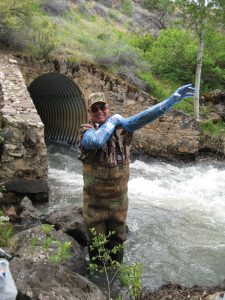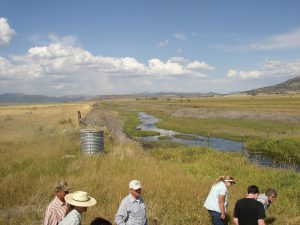Goose Lake, the state’s largest closed basin lake
The Watershed at a Glance
The Goose Lake Watershed is a closed basin located at the northeastern corner of California extending well into south-central Oregon. The Goose Lake Watershed occupies about 1,100 square miles, of which about two thirds are in Oregon and one third in California. The lake itself is about 144 square miles with the majority of the water on the California side. This is a semi-arid region, and historically Goose Lake has gone completely dry during periods of extended drought. The lake and its tributary streams support a unique assemblage of native fishes that are adapted to waters relatively high in alkalinity and dissolved salts. Of particular prominence is the Goose Lake redband trout. The upper watershed area is mostly publicly owned (USFS and the BLM), while lower elevation private lands are used for livestock grazing and hay and grain production.
Hydrology
The major portion of inflow to Goose Lake comes from tributary streams on the eastside of the lake. On the California side of the basin are four major tributaries: Davis, Lassen, Willow, and New Pine Creeks. These streams are fed mostly by snowmelt, and the major runoff occurs during spring and early summer each year. In addition to surface runoff contributing to the volume of water that feeds Goose Lake, there is inflow from a series of distinct groundwater basins. Several small springs emerge from the lakebed itself. Historically, Goose Lake has both overflowed into the North Fork of the Pit River, and on several occasions gone completely dry. The lake reportedly last overflowed in 1881. The lake was dry in the summers of 1851–52, 1926, 1929–34, and most recently in 1992.
Water Quality

Water quality characteristics of Goose Lake are typical of closed basin lakes—high alkalinity and total dissolved solids. Water quality in tributary streams is generally good and supportive of the principal beneficial uses, i.e., coldwater habitat, recreation, and irrigation. Monitoring data for Goose Lake and tributary streams come from the 1966 Goose Lake Basin Study and the 1995 Goose Lake Water Quality Monitoring Report (both by the (RWQCB). For the past several years, the Goose Lake RCD has conducted water quality monitoring in compliance with requirements of the Central Valley RWQCB’s Irrigated Lands Discharge Program, and both the Fremont and Modoc National Forests have collected extensive data on stream temperatures.
Fish and Wildlife
There are eight native fishes of the Goose Lake Basin. Four of the species, Goose Lake redband trout, sucker, tui chub, and lamprey, are considered endemic to the area and known to spend at least part of their lives in the lake. During times of drought and low lake levels, tributary streams provide important refuge habitat for these species. The other four species are primarily stream-dwelling— the Pit-Klamath brook lamprey, speckled dace, Pit roach, and Pit sculpin. All of these fish are state and federally listed as species of special concern. Redband trout that spend part of their life cycle in Goose Lake are much larger than their stream-dwelling relatives and historically supported a commercial fishing operation at the mouth of Willow Creek. Populations have been highly variable from year to year, and no Goose Lake redband trout runs have been seen in Oregon since 1981 or in California streams since 1989.
The forest and sagebrush uplands are important habitat for mule deer and other wildlife species. During the fall and winter, Goose Lake provides resting habitat for large numbers of migrating waterfowl.
Vegetation
Upland areas are characterized by mixed conifer forest, open meadows, and sagebrush. The lower elevation, privately owned lands are used for irrigated agriculture, mostly pasture and hay with some specialty crops (seeds, grains, potatoes, alfalfa, and orchard crops).
Life in the Watershed

The Goose Lake Basin is an area of mixed ownership and multiple land use. Native Americans inhabited the basin for centuries, beginning with the Modocs and Achumawis. Today, the local economy is supported mostly by ranching, timber production, and recreation. Most residents live in Lakeview, Oregon, (population 2,800) or the small, rural communities of New Pine Creek and Davis Creek. Limited industrial uses in the basin include a mercury mine, gravel pits, small gold mines, and lumber mills.
Management Objectives
Cooperative management efforts in the Goose Lake Watershed began in the early 1990s with the formation of the bi-state Goose Lake Fishes Working Group (now the Goose Lake Watershed Council). Driven by apparent declines in native fish populations and the concern over federal and state endangered species listings, this group began formalizing tasks needed to protect habitat and fish species in the basin. The Goose Lake Fishes Conservation Strategy was prepared in 1996, and that document continues to guide management priorities for the basin. Management objectives are summarized as follows:
- implement a locally directed management program to address all activities that potentially affect watershed resources through a cooperative effort by landowners, agencies, and resource users;
- implement a management program that recognizes existing land uses, minimizes adverse economic impacts, and strives to maintain the rural agricultural nature of the watershed;
- protect and restore aquatic and terrestrial habitat consistent with the local basin potential given climate, geology, and land-forming processes; and
- protect and restore native fish species by providing adequate water quality and quantity, safe passage of migrants, and clean spawning, resting, and foraging habitat.
Management Organizations Active in the Watershed
Goose Lake Watershed Council
This bi-state organization was formed in response to concerns with declining native fish populations and potential listings under the federal Endangered Species Act. The group operates by consensus and includes federal and state resource agencies, local city and county representatives, resource advocate groups, and private landowners. The group generally meets at least twice per year to review the status of conservation projects, lake and stream conditions, fish population trends, and to discuss future management strategy.
Goose Lake Resource Conservation District
Goose Lake RCD has been one of the leaders of the bi-state watershed council and has implemented several stream-improvement projects on Lassen and Willow Creeks. These projects include fish passage improvements, livestock fencing, off-stream livestock water facilities, erosion control, and general stream and meadow restoration work.
